Discovering the Wonders of Real Amber Fossils
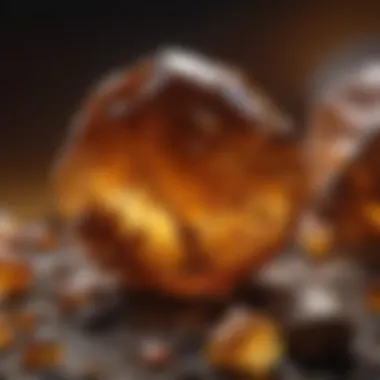

Intro
Amber fossils are not merely decorative items or relics from the past; they hold significant value in the fields of paleontology and geology. Amber is fossilized tree resin, a substance that can encapsulate and preserve the remains of ancient organisms, allowing scientists to study ecosystems millions of years old. The study of amber provides insights into the environmental conditions of its origin, the flora and fauna of the time, and the processes of fossilization. This article will illuminate various aspects of amber fossils, including their formation, characteristics, cultural significance, and their role in the collectibles market.
Featured Collectible of the Month
Overview
In this month’s spotlight, we focus on a remarkable piece of amber sourced from the Baltic region, known for its exceptional quality and diverse inclusions. Baltic amber is notable for its age, ranging from about 35 million years ago, and its light yellow to deep orange hues, often displaying a translucence that enhances its visual appeal. Collectors value this particular amber not only for its beauty but also for its historical and scientific relevance.
Historical Significance
The historical significance of Baltic amber stretches back to ancient civilizations. It was utilized as a form of currency and as a prized material in jewelry during the Roman Empire. The trade routes for amber extended from the Baltic Sea to the Mediterranean, illustrating its importance in commerce and culture in those times. The inclusions found within this amber often include prehistoric insects and plant materials, providing a fascinating window into the ecosystems of the past.
"Amber is not just a gem; it is a time capsule of our planet's history, capturing a moment in time that we can study and learn from."
Identification Techniques
Identifying authentic amber can be challenging for collectors. However, understanding its unique visual characteristics can aid in recognition.
Visual Characteristics
- Color Variations: Amber can range from pale yellow to deep brown or even blue. Each color can signal different origins or ages.
- Inclusions: Look for fossilized insects and plant matter. These inclusions are a hallmark of genuine amber.
- Light Tests: Natural amber is warm to touch and can sometimes be seen glowing under UV light.
- Static Electricity: Rubbing amber against a wool cloth can create static electricity, attracting light materials like paper bits.
Resources for Identification
For those interested in becoming proficient in identifying amber, here are some valuable resources:
- Wikipedia on Amber
- Britannica’s Entry on Amber
- Amber Enthusiasts on Reddit
- Amber Collectors’ Group on Facebook
Collector’s guidebooks can also provide in-depth information on identifying real amber and its common fakes. The more knowledge one has, the better equipped they will be to make informed purchasing decisions in the marketplace.
The significance of amber fossils extends beyond their aesthetic appeal, offering rich data for scientific endeavors and cultural relevance in a collectors’ sphere.
Prologue to Amber - A Unique Fossil
Amber, often seen as a simple gemstone, holds a profound significance in both natural history and human culture. Understanding amber goes beyond its aesthetic value; it offers insights into ecological conditions of the past. This section will address the formation of amber, its characteristics, and its relevance to collectors and researchers alike.
Defining Amber
Amber is fossilized tree resin, recognized for its vibrant colors and unique encapsulations. Unlike other minerals, amber originates from organic material. The resin, secreted by trees as a defense mechanism, undergoes a long transformation process. This metamorphosis takes thousands to millions of years, adding to its allure and geological importance.
Real amber is valuable not only for its beauty but also for the inclusions that can be trapped within it. These inclusions may include insects, plant matter, or even microscopic organisms. They provide a window into the past, offering valuable data for scientists studying the conditions of ancient ecosystems.
Historical Context
The use of amber dates back to prehistoric times. Ancient cultures valued amber for its supposed magical properties and later as a material for crafting jewelry and artifacts. In regions like the Baltic, amber was extensively traded and sought after. It was found in burial sites, indicating its importance in spiritual or cultural practices. Collectors often seek these historical pieces that tell a story beyond mere decoration.
Additionally, amber has been connected to various myths and folklore. From the Greeks who believed it came from the tears of the sun, to its association with healing properties in ancient medicine, amber has captivated human imagination across eras.
"Amber is the preserved essence of ancient forests, encapsulating life that once thrived on the planet."
In summary, amber’s definition, historical significance, and cultural connections make it a unique fossil worthy of detailed exploration. As we progress through this article, the various aspects of amber will unfold, revealing its importance in both science and culture.
The Formation of Amber Fossils
The process of forming amber fossils is both intricate and significant, acting as the foundation for understanding the broader implications of amber in the scientific and collector communities. Amber is not merely a fossilized tree resin; its formation encapsulates a myriad of geological and biological processes that speak to the earth's historical narrative. By examining the formation of amber, we gain critical insight into paleoenvironments, ecosystems, and even ancient life forms that once thrived in those conditions. This section seeks to elucidate the essential components involved in the genesis of amber, offering readers a clearer grasp of its rarity and value, particularly from the perspective of rock and fossil collectors.
Origin of Amber
Amber originates primarily from the resin of coniferous trees found in prehistoric forests. As these trees exuded resin, it served to protect them from pests and pathogens. Over time, this organic substance underwent a series of complex transformations due to heat and pressure, which ultimately led to its fossilization. The age of amber can vary, dating back as far as 320 million years ago, with significant deposits found in regions such as the Baltic region, the Dominican Republic, and Myanmar.
Amber is particularly notable for its ability to preserve organic materials such as insects and plant matter, allowing scientists to study these inclusions to gain insights into ancient environments. The context in which amber is formed is crucial for understanding its characteristics and the potential for inclusions. The chemical composition of the resin, influenced by environmental factors, plays an important role in the eventual color, clarity, and durability of the amber.
The Polymerization Process
The transition from resin to amber involves a process called polymerization, whereby small organic molecules combine to form larger, more complex structures. This process not only alters the chemical makeup of the resin but also contributes to its physical properties. During polymerization, the resin undergoes oxidative reactions that thickens it and leads to a hardening effect.
As the resin ages, its volatile components evaporate. This results in a denser material that is resistant to decay. The polymerization process is essential for creating the unique characteristics of amber, including its toughness and ability to preserve fossilized organisms. It is through these chemical changes that amber becomes a medium for capturing snapshots of ancient life, giving researchers invaluable tools for studying past biodiversity.
Environmental Conditions for Preservation
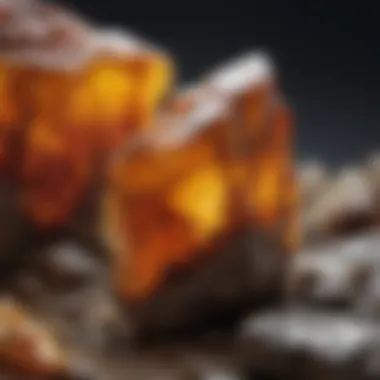
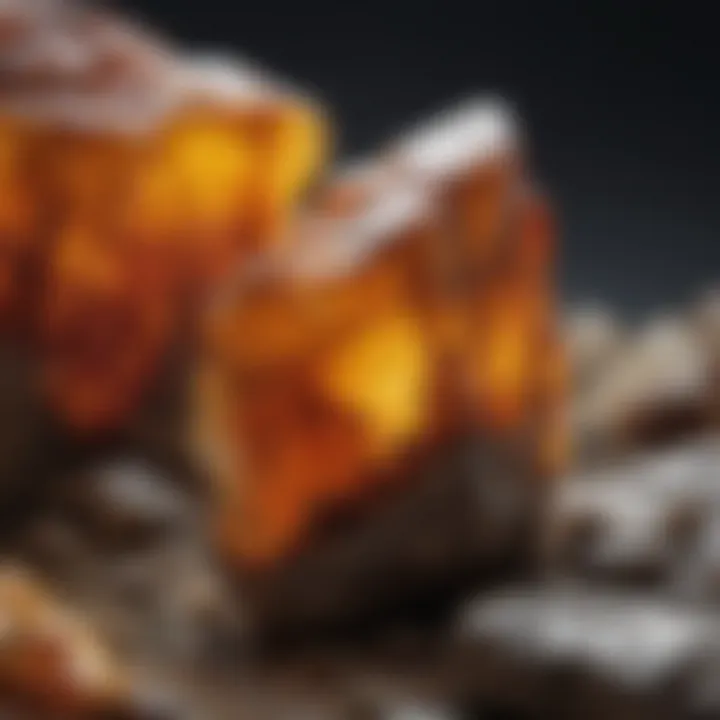
For amber to fossilize successfully, certain environmental conditions must coalesce. Ideal scenarios often involve the resin being buried rapidly in sediment. This prevents exposure to oxygen, which would otherwise accelerate decay. The temperature and pressure conditions also play a vital role in the preservation of amber.
The following conditions are conducive to the formation and preservation of amber:
- Rapid Burial: Quick sedimentation protects the resin from degradation.
- Anaerobic Environment: Low oxygen levels help prevent microbial decay.
- Stable Temperature: Moderate temperatures facilitate the slow chemical reactions necessary for polymerization.
- Lack of Water Flow: Excessive movement can dilute or remove resin deposits.
These environmental factors not only influence the composition and appearance of the amber but also determine the types and quality of inclusions found within. Collectors and enthusiasts should appreciate that amber's formation is a complex interplay of biological, chemical, and ecological factors.
Important Note: Understanding the process of amber formation enhances its appreciation not only as a collectible item but also as a critical resource in scientific research, revealing its layered history.
Characteristics of Real Amber Fossils
The characteristics of real amber fossils are critical to understanding their value and significance. Amber has fascinated scientists, collectors, and artists for centuries. Its unique qualities are appealing in both aesthetic and scientific contexts. Amber can provide insight into past ecological systems and preserve organisms that lived millions of years ago. This section elaborates on the unique physical properties and the various inclusions found within amber.
Physical Properties
Color Variations
Color variations in amber stem from its formative processes and the conditions under which it formed. Common colors include yellow, orange, and brown, but variations can occur due to the presence of impurities and environmental factors. The depth and richness of color impact the aesthetic appeal of amber, making specific shades particularly valuable in jewelry and collectors' circles. The vibrant range of colors allows artisans to create striking pieces, which attracts a broad audience.
However, the presence of specific hues can indicate the origin of the amber. For example, Baltic amber is often a deep golden color, while Dominican amber may exhibit a more translucent appearance. Such characteristics enable collectors to assess authenticity and origin, which is significant for both collecting and financial valuation.
Transparency Levels
Transparency levels in amber greatly influence its desirability. Some pieces are perfectly transparent, while others may be opaque or cloudy. The clarity of amber can change how inclusions appear within it. High transparency is often sought after, as it enhances the visual effect of internal inclusions, which can include ancient insects or plant matter. This clarity adds to the uniqueness and value of individual pieces.
On the other hand, opaque amber may still hold value for its color or the particular inclusions found inside. It can add character and distinction to pieces, especially in artisan jewelry. Thus, both ends of the transparency spectrum can attract different collectors.
Melting Point
Amber has a relatively low melting point compared to other fossilized materials, hovering around 100°C to 150°C. This characteristic is vital, especially during crafting and use in jewelry. It allows artisans to shape and mold amber without the risk of losing its integrity. This quality remains attractive for hobbyists and collectors alike.
Nevertheless, the lower melting point means that care must be taken when exposing amber to high temperatures. Pieces can become damaged or lose their value if improperly handled. Therefore, this property necessitates guided handling and specific preservation techniques for collectors, which are essential to maintaining the integrity of amber over time.
Inclusions in Amber
Inclusions found in amber are a fascinating aspect that enhances its scientific and aesthetic significance. These inclusions often comprise ancient biological organisms, including plants and insects. Their study offers a glimpse into past ecosystems, providing exceptional research opportunities in paleobiology.
Types of Inclusions
Inclusions in amber can be broadly categorized into organic and inorganic types. Organic inclusions commonly feature insects, spiders, and even small vertebrates, while plant material such as pollen, leaves, and wood can also be found. Each category provides unique insights; for example, insect inclusions allow scientists to study historical biodiversity while plant materials reveal information about ancient flora.
The significance of these inclusions contributes greatly to a piece's value. Specimens housing rare or well-preserved inclusions may command much higher prices and attract enthusiastic collectors who wish to possess a physical piece of history.
Significance of Inclusions
The significance of inclusions in amber is profound. They serve as crucial data points for studies in paleoecology and evolutionary biology. By studying these encapsulated specimens, scientists gain knowledge about the environments of the past and how species have adapted or evolved over time.
For collectors, inclusions enhance the narrative that accompanies each piece of amber. A specimen containing an insect trapped for millions of years tells a story that artificial materials cannot replicate. This enhancing quality makes amber study not only a scientific endeavor but also a compelling story of life's history embedded in natural art.
"Inclusions in amber are like time capsules that reveal the intricate details of ancient ecosystems and organisms."
Cultural Significance of Amber
Amber is more than just an attractive fossil; it holds deep cultural and historical significance across various societies. Its use in art, jewelry, and as a medium for storytelling reflects the multifaceted roles amber plays in human culture. Understanding this significance provides a richer context to the appreciation and value of amber beyond its geological and biological features.
Historical Uses in Art and Jewelry
Throughout history, amber has been favored by artisans and jewelers for its warm colors and unique appearance. Strongly associated with beauty, amber was commonly crafted into various decorative items. Ancient civilizations, including the Egyptians and the Romans, prized amber for its aesthetic qualities, fashioning it into beads and amulets.
The techniques employed to shape amber have evolved, but its beauty continues to captivate modern artists. Today, designs range from simple pendants to intricate sculptures. Its lightweight nature also makes it a popular choice for wearable art. Collections can be found in museums showcasing the evolution of jewelry design, emphasizing the longstanding appreciation for amber as material.
In addition, amber often found its place in tombs and burial sites, believed to hold magical properties or serve as a protective charm. This historical context reveals how amber transcends mere ornamentation, symbolizing status, spirituality, and connection to the afterlife.
Amber in Folklore and Mythology
Amber’s captivating appearance has inspired stories and myths across many cultures. In ancient folklore, it was often associated with the sun and its warmth. The Greeks referred to it as “electron,” linking it to the god of the sun, Helios. These narratives often sought to explain the origins of amber, contributing to an aura of mystery surrounding its existence.
In Baltic cultures, amber was deemed the tears of the sun or a conduit for divine energy. Many believed that carrying amber could bring good fortune or ward off illness. Similarly, in Slavic folklore, it was connected to the earth's spirits and was thought to possess healing properties. Modern interpretations still reflect these historical beliefs, as many collectors view amber not just as a fossil but as a bridge to the past.
Amber embodies cultural narratives that traverse time and geography, illustrating human fascination with this remarkable fossil.
As interest in amber grows, so does the recognition of these cultural elements. This awareness enhances both its collectivity as well as its appreciation across diverse audiences. By understanding amber's historical uses and its role in folklore, collectors and enthusiasts can engage with it on a deeper level, transcending the surface beauty to uncover a richer heritage.
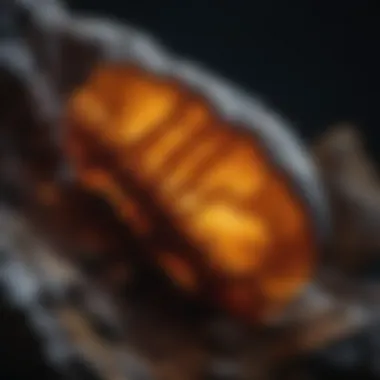
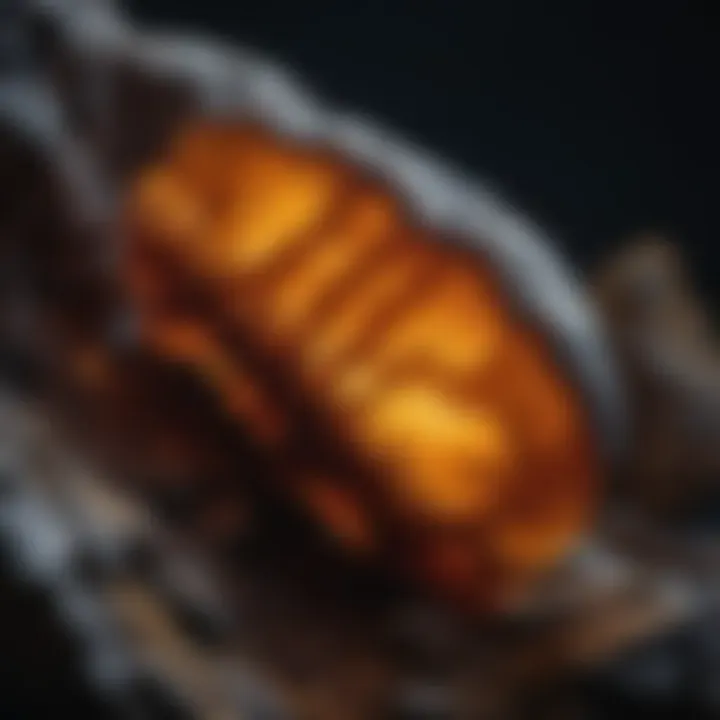
Identifying Real Amber
Identifying genuine amber is a critical skill for collectors and enthusiasts of fossilized materials. The ability to discern authentic amber from imitations or other resins can significantly impact the value and integrity of one’s collection. This section will detail various methods to identify real amber, highlighting visual inspection techniques and comprehensive testing methods.
Visual Inspection Techniques
Visual inspection serves as the initial approach to determining the authenticity of amber. When examining a specimen, collectors should look for certain key characteristics that are indicative of real amber. This includes aspects like color clarity, surface texture, and specific inclusions.
- Color Variations: Natural amber can present a wide range of colors, typically brown, yellow, orange, and even green or blue hues. However, overly bright or unnatural colors may indicate a fake.
- Surface Texture: Real amber usually has a smooth, slightly warm feel against the skin. The surface may also show tiny imperfections or an uneven surface texture due to the fossilization process, which adds to its authenticity.
- Inclusions: One of the most fascinating features of amber is its inclusions. These can be trapped insects, plant matter, or other small particles. Genuine amber has inclusions that appear organic and natural, often with rough edges and uneven shapes.
Testing Methods
Once visual inspection raises questions, more definitive testing methods can provide clarity.
Salt Water Test
The salt water test is one of the simplest and most effective methods for verifying authentic amber. This test involves submerging the specimen in a solution made of water and salt, typically at a concentration of around 25%.
- Key Characteristic: Real amber is less dense than this saline solution and will float. This makes the salt water test a popular choice among collectors.
- Unique Feature: The simplicity of this method makes it easily accessible. It requires minimal tools—water, salt, and a container.
- Advantages: The test is quick and can deliver immediate results. It is particularly beneficial for new collectors who may not yet be familiar with more complex verification methods.
- Disadvantages: However, floating does not guarantee authenticity. Some plastics may also float in salt water, so it should be combined with other tests for reliable confirmation.
Ultraviolet Light Test
The ultraviolet light test employs UV light to help identify real amber. When exposed to UV light, authentic amber will often fluoresce to a yellow or greenish hue.
- Key Characteristic: This property is distinctive to natural amber and can help differentiate it from synthetic resins and plastics.
- Unique Feature: The test is non-invasive and does not alter the specimen. This is especially important for collectors looking to preserve their items in original condition.
- Advantages: This method is highly reliable and can highlight characteristics not visible under normal lighting. It is a strong tool in the arsenal of any serious amber collector.
- Disadvantages: While effective, availability of UV light sources can vary. Additionally, not all amber will fluoresce; therefore, it should be used alongside visual inspections and other tests to strengthen accuracy.
The identification of real amber is not just a matter of accuracy; it’s about maintaining the value and scientific context of each specimen.
Collecting and Preserving Amber Fossils
Collecting and preserving amber fossils is an important topic for enthusiasts and collectors. The process of collecting not only allows individuals to appreciate these ancient materials, but also contributes to scientific understanding. Amber fossils can contain inclusions, which provide insights into historical ecosystems and the evolution of species. Therefore, correct methods in collection and preservation play crucial roles in maintaining the integrity of these valuable specimens.
Best Practices for Collecting
When embarking on the journey of amber collection, understanding the best practices is key. Firstly, it is vital to know the legal regulations in your area regarding amber collection. Some regions may have restrictions on collecting amber from natural sites to protect ecosystems.
Moreover, when collecting, choose sites where amber is known to be found, such as riverbanks and coastal areas. Always examine your surroundings and document the location of your finds. This documentation will enhance the scientific value of your collection.
Another best practice involves utilizing the right tools. A small shovel, gloves, and containers to transport the amber should be included in your collecting kit. Proper tools will help protect both the specimen and your hands.
Preservation Techniques
Preserving amber fossils requires attention to detail to ensure their longevity and aesthetic appeal.
Storage Conditions
Storage conditions are critical in preserving amber fossils. Ideally, amber should be stored in a cool, dry place away from direct sunlight. UV light can degrade the quality of amber over time, leading to color changes and loss of clarity.
A beneficial choice for storage is using acid-free boxes or cloth pouches that do not emit harmful chemicals. This type of protective environment minimizes exposure to elements that could damage the amber. However, maintaining constant temperature and humidity levels is a unique challenge and requires monitoring. Too much moisture can lead to mold growth, while excessive dryness might cause cracks.
Handling Guidelines
Handling guidelines are also essential in preserving amber fossils. It is crucial to handle amber with clean hands, as oils from your skin can affect its surface.
Always hold specimens by their edges to prevent any smudging or scratches on their fragile surfaces. Using gloves when possible is a beneficial practice, as this adds an extra layer of protection. As enthusiasts transport their collections for shows or exhibitions, soft padding is recommended to prevent any contact with harder objects that could cause damage.
The practices discussed above—both for collecting and preservation—serve to enhance the enjoyment and scientific value of amber fossils. Adhering to these guidelines ensures that these treasures from the past remain preserved for future generations to study and appreciate.
"Collecting amber is not just a hobby; it is a window into the Earth's biological history." - Unknown
By observing these practices, collectors can keep their amber fossils in optimal condition, allowing them to shine as both collectibles and scientific artifacts.
Ethical Considerations in Amber Collection
The collection of amber is not just a hobby or an investment; it is also steeped in ethical implications that cannot be overlooked. With the increasing interest in amber for both decorative and scientific applications, collectors need to reflect on their practices. Addressing the ethical considerations in amber collection promotes responsible engagement with this unique fossil. By being aware of legal frameworks and sustainability issues, collectors can contribute to the preservation of amber resources and respect legal guidelines.
Legal Aspects of Amber Trade
Amber trade is regulated in many countries, which raises important questions about legality and ownership. Laws can differ significantly, so it is essential for collectors to understand the regulations in their region. In some places, amber is protected as a natural resource. Collecting it may require permits or adherence to specific guidelines. Failure to comply with legal requirements can result in serious penalties including fines and confiscation of the collected specimens.
Collectors should also be aware of the provenance of the amber they wish to acquire. If the amber has been sourced from protected areas or through illegal means, its purchase contributes to an unethical trade. To promote responsible amber collecting, consider asking sellers for documentation proving the amber's origin. This leads to better practices within the amber market.

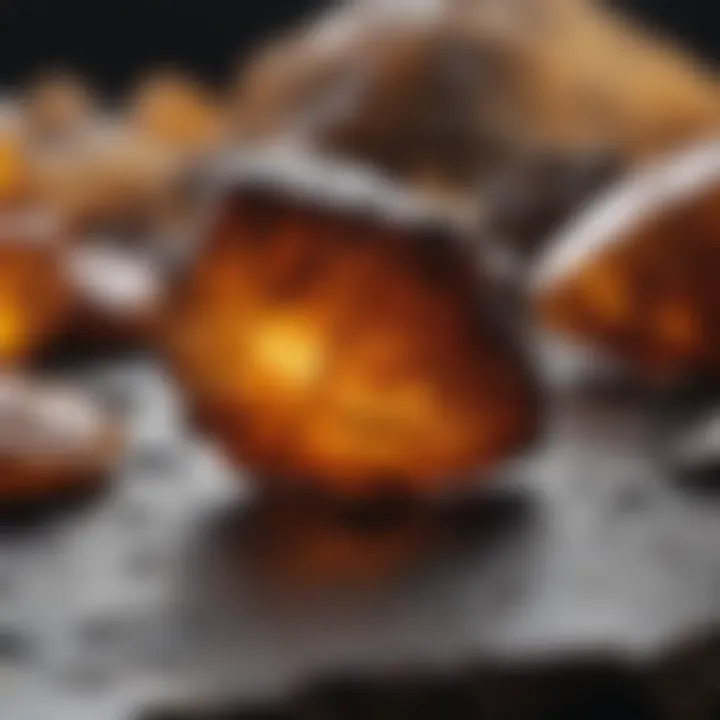
Sustainability Issues
Sustainability is another critical aspect of ethical amber collection. The extraction of amber can lead to adverse environmental impacts, especially when it involves unregulated mining practices. Unsustainable harvesting can deplete local resources and damage ecosystems. Collectors need to consider how their activities might affect the environment.
Moreover, as demand for amber increases, it is essential to support practices that ensure its availability for future generations. This can be accomplished by engaging with ethical sources that prioritize sustainable methods of extraction. Supporting ethical harvesting not only preserves the resource but also benefits communities that rely on amber trade as part of their economy.
"Collecting amber should not come at the expense of nature. It is our duty to ensure that future collectors can enjoy its beauty and scientific significance."
In summary, ethical considerations in amber collection encompass both legal and sustainability aspects. Understanding governmental regulations ensures compliance, while focusing on sustainability promotes conservation and respect for the environment. Collectors must reflect on their choices and strive to make responsible decisions that positively impact the amber collecting community.
Scientific Impact of Amber in Research
Amber is more than just a beautiful gem. It serves as a rich resource for scientific inquiry, contributing significantly to various fields including paleontology, ecology, and evolutionary biology. This section aims to highlight the relevance and implications of amber studies in understanding ancient ecosystems and evolutionary processes. The intrinsic qualities of amber fossils provide scientists with unique insights that would be difficult to obtain otherwise.
Paleoecology Studies
Paleoecology is the study of past ecosystems, and amber plays a vital role in reconstructing these ancient environments. Amber preserves not only itself but also a snapshot of life from millions of years ago, including plant materials, small organisms, and even droplets of ancient air. This preservation offers invaluable data about the climate and environment at the time when the amber was formed.
Researchers utilize amber samples to analyze various inclusions, such as insects and plant fragments. These inclusions allow scientists to determine the biodiversity of ancient habitats and provide clues about the interactions between species. In doing so, studies of amber contribute to our understanding of how ecosystems respond to environmental changes over geological time.
Observational techniques such as microscopy and imaging technologies further enhance the analysis of inclusions, revealing details about ancient ecosystems with precision. As such:
- Amber inclusions can indicate the geographic distribution of species at a particular time.
- Chemical analysis of these inclusions can provide insights into ancient climate conditions.
- Fossilized organisms preserved in amber can inform about evolutionary pathways and adaptations.
Insights into Evolution
The implications of amber research extend to understanding evolution. Fossils preserved in amber allow scientists to track evolutionary changes across millions of years, providing a well-preserved context for examining morphological adaptations and biological interactions. This is crucial in studying how species adapt to their environments and how these adaptations can lead to the emergence of new species.
Amber often contains not just single species but entire communities of organisms. For instance, by examining a piece of amber containing multiple insect species, researchers can infer the biological relationships and interactions among various organisms. The evolutionary history derived from these studies can reveal:
- Morphological trends in species development over time.
- Changes in ecological roles as species evolve and adapt to changes.
- Extinction events and their impact on biodiversity as evidenced by the fossil record.
Amber is a time capsule that provides insight into the intimate details of life forms that once existed, allowing scientists to connect the past with ongoing evolutionary processes.
In summary, the scientific impact of amber in research is profound and multifaceted. Through paleoecology and evolutionary studies, scientists can glean information about ancient environments and the evolutionary mechanisms that have shaped life on Earth. By understanding these elements, researchers not only enrich our comprehension of the past but also illuminate the paths that many modern species have taken to survive and thrive in a continuously changing world.
Emerging Trends in Amber Fossil Collecting
Amber collecting has evolved significantly in recent years. This evolution reflects shifts in technology, ethics, and market dynamics that influence how collectors engaged with this unique fossil. Delving into these emerging trends provides valuable insights for both seasoned collectors and novices.
Digital Collecting Communities
The rise of digital platforms has transformed how collectors connect and share knowledge. Online forums, social media, and dedicated websites allow enthusiasts to build networks with fellow collectors from around the globe. Platforms such as Facebook and Reddit have become vital spaces to discuss amber, exchange tips, and showcase finds.
Moreover, these digital communities foster a culture of collaboration. Collectors can analyze images, discuss provenance, and even identify inclusions through shared experiences. This virtual interaction encourages a sense of belonging and supports educational growth, making the learning process accessible to all.
"Digital platforms bridge the gap between collectors, providing a democratic space for everyone to learn and share."
The internet also plays a crucial role in sourcing information regarding the significance and value of different amber specimens. Collectors can easily access resources on historical uses, current market trends, and ethical considerations, promoting a well-rounded understanding of amber collecting.
Market Value and Trends
The market for amber fossils has seen fluctuations influenced by factors like demand, rarity, and quality. Recent years have noted a concerning rise in the popularity of synthetic ambar and imitations, urging collectors to deepen their knowledge to differentiate between real and fake specimens. This awareness not only protects their investments but also preserves the integrity of the collection.
Furthermore, the trend of investing in amber is growing. Collectors regard high-quality specimens as appreciating assets. Unique pieces, especially those containing well-preserved inclusions, garner higher prices in auctions. Consequently, understanding market values becomes essential for anyone considering entering the collecting scene.
Some key factors affecting market trends include:
- Rarity: Specimens with unique inclusions or coloration are harder to find and tap into premium prices.
- Authenticity: Verified real amber commands a different price point compared to imitations.
- Environmental consciousness: Focus on sustainable and ethically sourced amber is shifting buyer preferences.
As these trends shape the collecting landscape, they underscore the importance of knowledge. Buyers and sellers alike must stay informed to navigate this evolving market efficiently.
Culmination
The topic of amber studies encapsulates not only the scientific intricacies involved in its formation but also the cultural dimensions that add richness to its legacy. Understanding amber's formation is crucial for fossil collectors and researchers alike. Real amber fossils provide insights into the ecosystems of the past while serving as valuable objects of aesthetic and historical significance.
The Future of Amber Studies
Looking ahead, the study of amber holds immense potential. Advances in technology are allowing researchers to examine amber in ways previously not possible. High-resolution imaging and molecular analysis reveal information about ancient life forms trapped in these fossilized resins. The ability to retrieve DNA from inclusions in amber is a groundbreaking aspect that could transform our understanding of prehistoric biodiversity.
Furthermore, digital platforms for sharing amber discoveries and discussions continue to thrive. Online communities on Reddit or Facebook foster relationships among collectors and enthusiasts across the globe. These platforms facilitate knowledge sharing, enabling more people to appreciate the complexities of amber.
For policymakers, understanding the significance of amber in both ecological and commercial contexts will be essential in shaping future regulations. As demand for amber grows, sustainable practices must be enforced to protect vital ecological resources.
As an encapsulation of history and evolution, amber studies will remain critical. Supporting research initiatives will help scholars continue to unveil the layers of information locked within amber fossils and enhance our collective understanding of Earth’s biosphere.
"Amber is more than just a stone; it is a treasure trove of ancient history, waiting to inform and inspire future generations."
In summary, the future of amber studies is promising and vital. It represents an intersection of science, culture, and responsible collecting, all of which are relevant for today's society. Encouraging responsible practices will ensure that this precious resource is preserved for future explorers and scholars.



